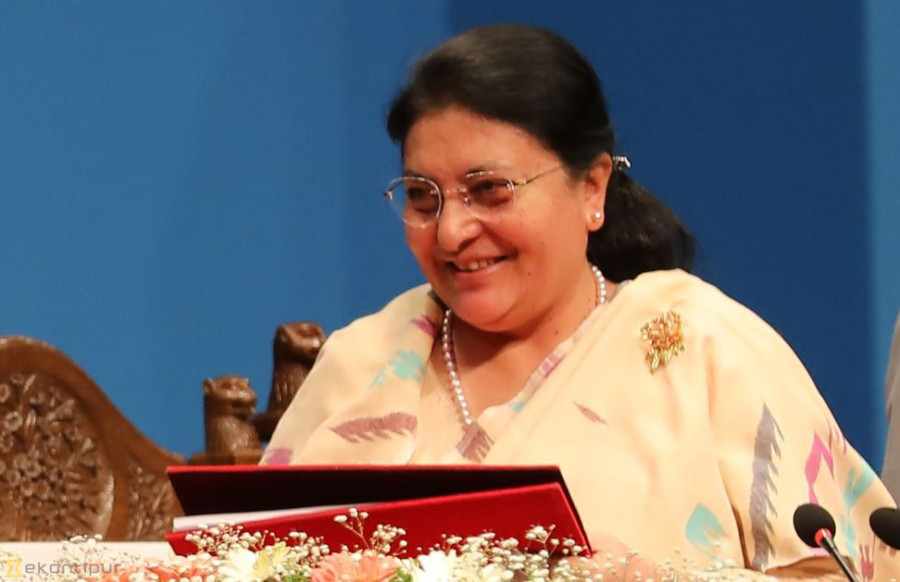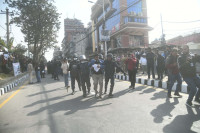Opinion
Old wine in new bottle
The government’s policies and programmes for 2019-20 look like more of the same.
Jagadish Prasad Bist
Unveiling the government’s policies and programmes for fiscal 2019-20 in Parliament last week, President Bidya Devi Bhandari said, “My government envisions the fiscal year 2019-20 to be the year of fastest development growth in history.” The phrase my government set off a storm of protest on social media, overshadowing, for a while, the policies and programmes in the budget statement. Opposition member Gagan Thapa came down heavily on the president and stated that the policies and programmes had nothing to do with the interest of the general public. Even ruling party leader Pushpa Kamal Dahal, chairman of the Nepal Communist Party, stated that he had no knowledge about the inclusion of the phrase my government. Former finance minister Surendra Pandey said that the phrase Government of Nepal was the appropriate phrase.
Economists have also started slamming the policies and programmes of the government. They said that the draft looked like a wish list. And the government’s failure to back the programmes with action plans raised questions over the practicality of the policies. Economists further stated that the country had not been able to build its economic foundation as strongly as the government had been trumpeting, and hence double-digit growth in the next four years was farfetched. To this end, though most of the programmes are getting disapproval from economists due to the government’s failure to draft an action plan, some programmes are also becoming popular among investors and the general public. For example, the inclusion of one-stop service facility has been getting popularity among investors. Therefore, let’s analyze how realistic the current proposed programmes are.
First and foremost, what is important to note here is that most of the populist programmes embraced in the current draft simply resemble the same from last year. Like graduating the country from low income to the status of middle income within the next 10 years, achieving a two-digit growth rate within the next four
years, connecting the district headquarters of Humla and Dolpa to the national highway grid, inaugurating and prioritizing the construction of the China-Nepal-India railway, completing the much awaited and touted Melamchi project within the coming fiscal year, and inaugurating stadiums in each province are a few of them.
It is also important to note that some of these projects also fall under the priority of the 15th five-year
plan recently drafted by the National Planning Commission. Therefore, economists are criticising such
policies as nothing but propaganda because fiscal plans should not be the same as long-term periodic plans. Other populist programmes include the creation of 500,000 jobs and the revision of social security plans and programmes. But the president said nothing about how the government planned to achieve the same.
The contradiction here is the difference between the nature of the prioritised programmes and the expected outcomes. The argument is that the creation of jobs in such a large volume within a year needs priority projects with short-term investments. However, since most of the programmes having a large economic effect are either in the files or supposed to start at least after two years, the draft gives much room to doubt these objectives.
Similarly, the execution of the social security plan is also getting the side-eye. As most of the organisations have not yet registered for the same, and some are saying that it is beyond their capacity, economists are arguing that full implementation of such programmes is not going to be easy. Another side of the social security plan, which includes increasing the social security allowance to elderly citizens to Rs5,000 monthly, is also said to be a populist move which the government cannot afford. Further, the inclusion of some large projects costing Rs25 billion are construed as unnecessary and a burden to the nation by the general public and economists. Thus, these issues have been seen with much attention because the incumbent finance minister himself had opposed the same earlier.
The president also stated that all economic transactions would be conducted through the banking system. However, since a majority of Nepalis still don’t have access to formal financial services and lack financial literacy, such programmes cannot happen within a year. For example, according to Nepal Rastra Bank, more than 25 percent of local units still do not have even a single branch of commercial banks. Likewise, the decreasing portion of farm land and rain-based irrigation system in Nepal cast doubts on the expected growth in agriculture. For instance, according to the Ministry of Agriculture and Livestock Development, only 50 percent of the cultivable land has irrigation facilities, the rest depends on seasonal rain.
In conclusion, the present government has given continuity to the culture of showcasing big projects as fiscal policies. Except one or two, the policies and programmes look more populist than realist. Thus, it would not be wrong to interpret these programmes as old wine in new bottle. But since the new budget is yet to be presented, it will be interesting to see how the government addresses the issues and challenges of the proposed policies and programmes through action plans because it does not hold a commendable history of the same.
Bist is a member of the faculty at Uniglobe College.




 10.12°C Kathmandu
10.12°C Kathmandu.jpg)










